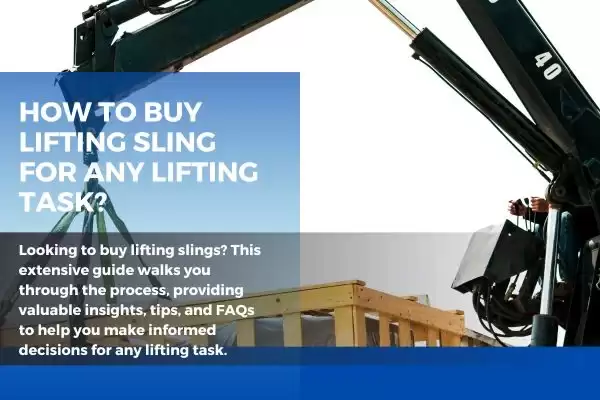100 %

Oct 4,2023
Lifting heavy loads is common in many industries, from construction to manufacturing. However, ensuring safety and efficiency in these operations requires the right equipment. One crucial component in this process is choosing the correct lifting sling. This comprehensive guide will walk you through every aspect of purchasing a lifting sling to ensure you make an informed decision that suits your specific needs.
One of the first steps in choosing the right wholesale lifting sling is to assess your specific lifting needs. Consider the weight capacity requirements, environmental conditions, and the material of the load. For instance, if you're working in a corrosive environment, you'll need a sling to withstand those conditions. Additionally, understanding the number and location of rigging points will influence your choice of sling.
Safety should always be a top priority when it comes to lifting operations. Regular inspection and maintenance of your lifting sling are crucial to ensure it remains in optimal condition. Understanding load calculations and the load's center of gravity will help prevent accidents or damage to the sling. Proper storage and handling are also essential to extend the lifespan of your equipment.
Compliance with safety regulations and industry standards is non-negotiable. The Occupational Safety and Health Administration (OSHA) provides guidelines for safe lifting operations. Additionally, different industries may have specific standards that must be adhered to. Ensuring compliance with these regulations will keep your workers safe and protect your business from potential liabilities.
Choosing the right size and length of the lifting sling is crucial for safe and efficient lifting operations. Calculating the correct length involves considering the distance between the load and the rigging point and any angles that may affect the load distribution. In some cases, custom-length slings may be necessary to meet specific requirements.
The material of the lifting sling is another critical factor to consider. Different materials offer varying levels of strength, durability, and resistance to environmental factors. For example, nylon and polyester webbing slings are popular due to their high strength-to-weight ratio and resistance to mildew and chemicals. Wire rope slings and chain slings are better suited for heavier loads and harsher environments.
The end fittings of the lifting sling connect it to the load and the rigging points. Choosing fittings compatible with both the load and the rigging points is important. Consider factors such as the type of hook, shackle, or attachment that will be most secure and effective for your specific application. Safety features like self-locking mechanisms can provide an extra layer of protection.
While it's essential to prioritize safety and quality, budget constraints are a reality for most businesses. Understanding the pricing factors in purchasing a lifting sling will help you find the right balance between cost and quality. Investing in a high-quality sling may save you money in the long run by reducing the risk of accidents and equipment failure.
Choosing a reputable supplier and brand is a crucial step in the purchasing process. Researching suppliers, reading product reviews, and checking for certifications can help ensure you're getting a quality product. Additionally, consider factors like warranty and customer support to provide peace of mind in case any issues arise after the purchase.
Selecting the right lifting sling for your specific lifting task is a decision that should not be taken lightly. Following this comprehensive guide will equip you with the knowledge and understanding needed to make an informed choice. Remember, prioritizing safety, compliance with regulations, and quality will ultimately lead to safer and more efficient lifting operations for your business. Invest the time and effort now, and you'll reap the benefits in the long run.